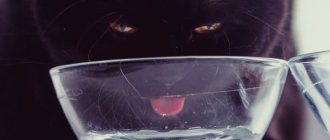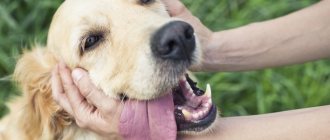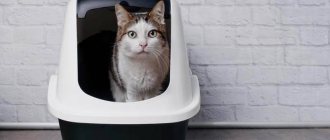Polydipsia in dogs is a phenomenon expressed in the fact that the animal absorbs water in huge quantities, significantly exceeding the body's daily need for fluid. Sometimes such a phenomenon may be due to the fact that the female is pregnant or during the feeding period, but in most cases, if she begins to drink a lot of water, this is a sign that pathogenic processes are taking place in her body. Therefore, the owner must be attentive to such a phenomenon, and if the dog’s thirst becomes completely uncontrollable, he must take him to the veterinarian for an examination. The article will discuss factors that influence why a dog drinks so much, “background” diseases associated with this phenomenon, as well as treatment methods.
Water consumption rate for dogs
Experts indicate that dogs in a healthy state can drink from 50 to 100 ml of liquid for every kilogram of weight. If the volume is exceeded, then this indicates excessive thirst, which means you need to look for the source of the deviation from the norm.
A dog that drinks a lot should alert its owner
For your information! An animal weighing 20 kg should not absorb more than 2 liters of water in one day. With a body weight of 30 kg, the normal volume is 3 liters of liquid.
If you suspect a deviation, it is necessary to take measurements. In addition to water, the list includes kefir, yogurt, broth, milk, liquid cereals, etc. The primary sources of changes in a dog’s behavior include the following factors:
- certain season;
- pet’s body structure - height, weight, etc.;
- motor and physical activity;
- age of the animal;
- wool length.
The amount of fluid you consume also depends on the type of food you eat. When eating 0.5 kg of dry food, a dog needs about 1.25 liters of drink. When feeding natural food, the ratio of the two indicators should be approximately equal. If the food is too salty, the volume of water can increase significantly.
Pets living in private houses or apartments increase the amount they drink with the arrival of the heating season. Increased dryness of the air compensates for the loss of body moisture. An increase in fluid used may also be associated with individual metabolic characteristics: an anomaly is observed in puppies, during pregnancy, and when feeding babies.
Note! As dogs get older, they begin to feel thirstier. They prefer to approach the bowl often and lap it up in minimal portions. The problem is associated with the peculiarities of the internal organs and the accelerated excretion of fluid by the kidneys.
The amount of water a dog should drink daily
It is believed that in normal condition a dog should drink about 50-100 milliliters of water per 1 kilogram of its weight per day. If the amount of liquid is more than this limit, we can talk about its excessive consumption. In this case, it is important to understand why the dog drinks so much liquid. A dog that weighs 10 kilograms should consume no more than 1 liter of liquid in 24 hours.
An animal weighing more than 30 kilograms per day should drink up to 3 liters of water. In this regard, to consume the exact volume, you should measure the amount of liquid throughout the day. This applies not only to the water itself, but also to other liquids - yogurt, kefir, milk, broths, cereals, etc.
The amount of water a dog consumes is influenced by quite a few different factors. Among them
- veterinarians distinguish the following:
- specific time of year;
- the constitution of the animal's body;
- the dog’s activity level and age;
- wool length;
- age, etc.
It's worth noting that the type of food consumed will also significantly influence how much a dog drinks. For example, if an animal has eaten about 500 grams of dry food, then it needs approximately 1.25 liters of water. As for ordinary natural food, the ratio of liquid and food should be the same. If the food is quite salty, the volume of water can increase significantly.
During this period of time, pets living in houses or apartments are faced with the fact that due to heating, the indoor air becomes very dry. This forces them to constantly go to a bowl of water, because they are constantly losing moisture from their bodies.
Due to certain specific factors, such as metabolic rate, in some cases the animal may consume more fluid. First of all, this applies to the growing bodies of puppies, pregnant and lactating bitches, as well as aging dogs. The latter also always drink small doses of water.
What to do about this problem
First of all, when observing an increase in your dog's water intake, it is worth paying attention to its diet. All salty foods and salt itself should be completely excluded from it. If the feeling of thirst appears after changing the type of food, do not worry too much. In this case, it is only important to provide the animal with a constant supply of fresh, clean water. Over time, the pet will get used to it and return to its previous drinking regime.
If the reason is not food, you should definitely measure her body temperature. If it is elevated, you should seek help from a veterinarian. This symptom often appears at the very first stages of the development of many diseases, which allows them to be influenced in time.
In aging dogs, special attention should be paid to the condition of the liver and kidneys. Often these organs can gradually fail with age. Therefore, the doctor must conduct a full range of various biochemical examinations to determine the degree of functionality of the vital systems of the body.
It is important to note that under no circumstances should you limit your dog’s water intake. His body often does the right thing when it requires a lot of fluid. But there are two exceptions to this rule. They consist in the presence of swelling in the pet’s body, as well as the consumption of water after vomiting. These symptoms indicate quite serious health problems that need to be addressed immediately in a veterinary clinic.
It is worth understanding that an animal’s thirst is often caused by completely harmless reasons that do not require any panic from the pet owner. For example, in childhood, a child can feed the dog chocolates. It is impossible to keep track of this, but the consequences of this “food” intake can lead to an increase in water consumption. That is why you should not be afraid, as this can only lead to inappropriate actions towards your dog.
What to do at home
A sick animal should be provided with a calm, quiet and warm place, protected from drafts, out of the reach of small children and other pets. You need to give your dog plenty of water, or whatever the vet says. If she urinates on herself, you will have to use diapers.
Medicines are given strictly as prescribed by the doctor, without trying to treat the dog yourself. It is especially dangerous to give your dog medications intended for humans.
The water given to the animal must be clean and boiled. It must be changed regularly and the dishes must be washed thoroughly.
The diet needs to be checked and foods that can provoke and stimulate thirst should be excluded. If excessive water consumption is caused by switching the dog exclusively to dry food, it is necessary to provide it with constant fresh drinking water in large quantities.
You can feed the animal as usual if it is not sick and the cause of thirst was not the food itself. If there is a disease, you need to make sure that it is easy for the dog to eat food, if necessary, grind it more or even put it through a meat grinder.
The most important thing a dog needs during illness is the attention and love of its owners, so spend more time on it. This will help you recover faster.
Excessive water consumption by dogs: main reasons
Why does a dog eat dirt on the street: the reason
Thirst in dogs without accompanying clinical signs indicates the influence of certain factors on its body:
- the dog became hot. The deviation is observed when the heating is running, in the summer heat. Thick and long wool plays an important role: it warms well in winter, but causes overheating in a warm room;
- eating salty foods. When eating fish or other foods, the body automatically tries to reduce the amount of salt by removing it along with the liquid;
- during pregnancy. Large volumes of water are required not only by the mother, but also by the babies in the womb;
- eating spoiled foods. The animal begins to absorb water to neutralize toxins that come with poor-quality food;
- stressful situation. Fear or strong excitement causes an increased urge to go to the toilet; to replenish losses, you have to absorb large volumes of liquid.
Important! Physiological thirst in dogs can be provoked by a deficiency of protein, which is necessary for the building functions of the body. Attempts to constantly feed the animal with cereals and the absence of meat products lead to uncontrolled drinking.
Pregnant dog drinks a lot
Diseases accompanied by increased thirst
Diseases accompanied by increased thirst almost always manifest themselves acutely and threaten the life of the animal. Polydipsia is the scientific name for uncontrollable thirst in animals and humans.
Below are just some of the diseases that may be accompanied by polydipsia:
- Purulent inflammation of the uterus (pyometra) in bitches.
- Intoxication of the body (poisoning).
- Diabetes mellitus and diabetes insipidus.
- Diseases of the kidneys and genitourinary system.
- Dehydration.
- Bleeding, including internal.
- Fever (increased body temperature).
- Tumors.
- Injury.
- Stress.
- Inflammatory processes in the brain.
- Burns.
- Thyrotoxicosis (hyperfunction of the thyroid gland).
- Mental disorders.
Note! Polydipsia can be a consequence of taking certain medications.
Briefly about the main thing
- Dogs require water for the normal functioning of their entire body. Lack of fluid leads to slow metabolism, exhaustion and disease.
- Dehydration can be determined by pressing on the gums or by pulling the skin between the shoulder blades.
- The average daily intake for dogs is 20-70 ml per 1 kg of weight. The total volume depends on the weather, lifestyle, and diet.
- If the dog is only eating and refuses water, he needs to be given a rehydration solution or forcefully injected with a syringe.
Has it ever happened to you that your dog refuses to drink at all? Share in the comments how you dealt with this problem.
Poisoning
Poisoning in dogs often occurs due to the fault of the owner. You can get poisoned:
- low-quality or expired food,
- “human” food left unattended;
- street or indoor plants;
- household chemicals;
- food picked up on the street;
- due to an incorrectly formulated diet.
Signs of poisoning:
- salivation;
- vomiting and diarrhea, possibly with blood;
- heavy breathing and restlessness;
- lack of coordination;
- fast heartbeat;
- convulsions, loss of consciousness.
Polydipsia occurs due to the fact that the quadruped vomits. The body strives to replenish the water balance. Take your pet to the vet immediately!
Possible diseases of dogs leading to this condition
A dog eats grass on the street: what is the reason?
If a dog asks and drinks a lot of water, and the basic physiological prerequisites for thirst are absent, then the question is about a latently developing disease. Liver pathologies are considered serious damage with the appearance of a sagging abdomen, darkening of urine, regular visits to the street, and painful sensations in the hypochondrium area. The formation of hepatitis, liver failure, or cholangitis (inflammation of the bile ducts) can make your pet want to drink constantly.
Important! There are other provocateurs of irrepressible thirst in a dog. Most of them have specific manifestations and are easily recognized.
Kidney diseases
Dysfunction of paired organs leads to increased fluid intake and regular trips to fresh air. Acute kidney dysfunction can cause severe dehydration within 24 hours. But in older pets with similar symptoms, the problem indicates the development of a chronic form of the disease. This point must be taken into account when visiting a veterinarian and describing the animal’s condition.
Active excretion of urine, or polyuria, allows the dog’s body to rid itself of accumulated waste after metabolic processes. With kidney disease, harmful toxic substances begin to accumulate, and the dog drinks water to quickly remove them. This approach does not solve the problem, but worsens it. The accumulation of excess fluid in the tissue leads to swelling, making it difficult for the dog to breathe. Moreover, deviation can lead to the death of the pet.
Kidney failure in dogs
Diabetes mellitus in dogs
Serious pathologies include disorders of the endocrine system and pancreas. Insufficient production of insulin, which is responsible for carbohydrate metabolism, provokes the formation of secondary diseases. Aggravating pathologies in old dogs include developing blindness.
Important! It is impossible to independently determine diabetes mellitus. A visit to a veterinary clinic and tests are required. Whether it is a Yorkie or a Husky, any dog needs symptomatic therapy; home treatment is impossible.
Cushing's disease
The secondary name of the pathology is hyperadrenocorticism. It provokes an imbalance of cortisol in the dog’s body. Arises as a response to serious injury or proliferation of atypical tissue in the adrenal glands and pituitary gland.
In healthy pets, cortisol levels are at minimum levels and increase during a stressful situation. When it increases for no reason, active production of glucose begins, which provokes a constant desire to drink.
Note! Secondary signs of Cushing's syndrome are the appearance of focal alopecia (local hair loss), a persistent desire to relieve oneself and a refusal to walk or run or play.
Cushing's syndrome in dogs
Psychogenic polydipsia
The pathological condition refers to behavioral deviations. Its nature is poorly studied, but most experts are confident that uncontrolled absorption of water in puppies is associated with interruption of feeding with mother's milk. In adults, the anomaly is observed after suffering severe dehydration. The problem is dealt with by a veterinary neurologist.
Important! In puppyhood up to a year, another deviation may be observed - hypercalcemia. It occurs in response to a constant pile of calcium in the diet. As it develops, babies refuse to eat, but drink a lot. The consequences of the pathology are deformation changes in the limbs and stunted growth of the dog.
Dog spinal injury
Damage to the spinal column is also a prerequisite for this problem. Certain breeds are predisposed to its injuries: dachshunds, basset hounds and other subspecies with an elongated body.
When a pet appears unsure and weak in its gait, lethargy and apathy, there is a risk of pinching the spinal nerves. Secondary manifestations of the disease are excessive drinking and constant walking (possible incontinence and refusal to ask to pee).
Stomach ulcer
Ulceration of the mucous membranes occurs in response to an incorrectly selected diet or the consumption of aggressive chemicals. If there is internal bleeding, the animal requires emergency surgery. Signs of an ulcer include sudden attacks of vomiting, the presence of red or brownish foreign matter in the vomit.
Important! Severe bleeding can cause weakness and short-term loss of consciousness (due to pain and blood loss). The animal requires urgent diagnosis and therapy.
Colds and infectious diseases
Damage to the canine body can be caused by a large number of viral and bacterial pathogens. It is impossible to make a diagnosis on your own. A visit to the veterinarian is warranted if the following symptoms are present:
- stable increase in temperature;
- attacks of vomiting and indigestion;
- change in the shade of the mucous membranes.
Note! A high temperature does not indicate a cold. It can accompany damage to the thyroid gland, hormonal imbalances, heart pathologies, bleeding and viral infections.
Diabetes insipidus in dogs
This form is directly related to dysfunction of the hypothalamus and pituitary gland. It causes frequent urination and an unconscious desire to replenish fluid lost by the body. To confirm suspicions, it is enough to analyze the animal’s nutrition and the number of walks it requires (for some, every half hour).
If a dog drinks too little and urinates too much, then there is a possibility of developing diabetes insipidus of central or renal origin (with the inability to reabsorb fluid).
Food or chemical poisoning
Intoxication with food or chemicals leads to:
- lack of appetite and refusal to eat;
- digestive upset such as constipation or diarrhea;
- an indifferent state and a decrease in temperature;
- changes in the color of the mucous membranes - redness or blanching;
- because the animal begins to vomit.
Note! If an elderly dog, in addition to thirst, has a gag reflex, and the gastric secretions smell like rot, then the problem is related to age-related dysfunction of the kidneys or liver. The pathological condition is accompanied by low temperature.
Poisoning in a dog
Piroplasmosis
Blood parasitic disease, which is provoked by ixodid ticks (which are carriers of parasites), is characterized by the following clinical picture:
- apathetic state;
- refusal to eat;
- the appearance of blood particles in the urine.
The disease leads to fever, yellowing of the mucous membranes, and anemia (due to blood loss).
For your information! Ignoring the signs of piroplasmosis can be fatal for a quadruped. Violation of vascular conductivity will lead to a stop in the excretion of urine from the body, rapid accumulation of fluid in the tissues, disruption of cardiac activity and collapse.
Pyometra
Inflammatory processes in the uterus cause symptoms similar to bacterial and viral infections. It is impossible to identify them without a veterinarian and diagnostics. Signs of pathology include:
- apathy and lethargy;
- attacks of nausea, diarrhea;
- severe pain in the abdominal area;
- constant change in temperature: from high to low.
Note! Oncology can masquerade as pyometra. In the first case, similar symptoms are observed, to which are added an unpleasant odor from the mouth, weight loss and discharge from the loop.
Pyometra in a dog
What accompanying symptoms should alert you?
If none of the non-dangerous reasons are suitable, study the accompanying signs. Pathology should be suspected if the following symptoms appear:
- depression, drowsiness, causeless aggression and loss of appetite;
- increase or decrease in temperature;
- changes in the color, consistency, or odor of urine or stool;
- pain when urinating;
- repeated vomiting and diarrhea;
- purulent discharge from the eyes;
- abdominal enlargement and swelling;
- sudden loss or gain of excess weight;
- yellowing of mucous membranes and skin;
- rapid and noisy breathing.
If the listed symptoms appear, the pet must be taken to a veterinary clinic. Before making a diagnosis, avoid self-medication so as not to worsen the existing condition and blur the clinical picture.
Consequences of not drinking
If your dog is eating but not getting enough water, this can lead to a number of serious problems. Possible consequences:
- decreased activity, lethargy and lethargy;
- change in skin tone;
- deterioration of joint function, pain when walking;
- disruption of the functioning of all internal organs;
- slowing down metabolism;
- departure against the background of stagnation of toxins in the body;
- development of chronic diseases.
A prolonged absence of water leads to severe exhaustion of the animal. If the necessary measures are not taken in time, this can result in death. This is why it is important to respond to signs of dehydration as quickly as possible, especially if you have an older dog.
How to measure your dog's water intake
Why cats are afraid of water - reasons for fear of bathing
To clarify the lack or excess of daily drinking, you need to:
- Calculate the standard for your own pet: for every kilogram of body weight, 50 to 100 ml of water is required.
- Determine the total volume of liquid contents. In addition to the water in the bowl, you need to add broths, kefir, milk, yoghurts, etc.
- Print the total value.
If the numbers are slightly inflated, but the deviation is justified by hot weather, active games, feeding puppies or other physiological reasons, then the animal is not in danger. If they are absent, the pet needs to consult a veterinarian.
Is it normal for my dog to drink a lot?
While excessive water drinking that is out of character for your dog may signal a problem, some dogs may simply be drinking a lot of water.
“Some dogs naturally drink water excessively,” says Kolokolnikov. “They tend to be large, playful dogs that like to have fun drinking water or are very active and need to rehydrate due to panting.”
The most important aspect in deciding whether there is a problem is determining the change in baseline water consumption.
Try to know how much your dog drinks on a regular basis, take note and consult your veterinarian if the amount suddenly increases or decreases.
How much water should a pet drink per day?
The amount of water per day depends on weather conditions, physical activity, type of feeding and size of the pet. With dry food, more fluid is required, since the food causes a feeling of thirst after entering the stomach. The norm of fluid consumption for dogs is 20-70 ml per kg of pet weight per day. If your pet drinks less in cool weather, there is no need to worry. A dog can get moisture from natural food by eating snow, which is often found in huskies, malamutes and Samoyeds.
Photo: nellis.af.mil
Useful video
To learn what to do if dogs are thirsty, watch this video:
Similar articles
- Kidney failure in dogs: symptoms, acute...
The owner observes increased thirst in the dog and frequent urination. At this point, 50–55% of nephrons die. Read more - Heart failure in dogs: symptoms - cough...
In some cases, pets experience increased thirst. Cough. In the initial stage of the disease, the owner observes rare attacks of dry cough in the dog. Read more
- Cholecystitis in dogs: symptoms, acute and chronic...
Symptoms in a dog. The clinical picture of the disease is characterized primarily by indigestion. ... Thirst persists. Read more
- Nephritis in dogs: causes, symptoms, treatment, including...
Symptoms of pathology in dogs. The effect of one or another negative factor... The dog has a hot and dry nose, increased thirst. The general condition is depressed. Read more
- Asthma in dogs: signs and symptoms, how to relieve an attack...
Asthma can appear in a dog either as a congenital disease or under the influence of external factors. ... Thirst is increased. Read more
Diagnosis of a dog in a veterinary clinic
Seeking professional help is justified if the following signs are present:
- a constantly depressed state, when the animal tries to lie down, avoids active games and tries to quickly return from a walk;
- fever with hot ears and dry nose;
- painful and regular trips to relieve, the presence of particles of pus, blood or mucus in the urine;
- a sharp deterioration in health with attacks of vomiting, diarrhea, discharge of pus from the eyes;
- abnormal abdominal enlargement;
- if the dog gets tired quickly, begins to lose weight or gain weight.
Ultrasound examination of the dog
When visiting the clinic, the doctor will conduct a general examination and begin asking about the behavior characteristics and time of the appearance of the animal’s poor condition. After a preliminary diagnosis has been made, he will be prescribed the following:
- general and biochemical blood test;
- clinical urine analysis;
- Ultrasound, x-ray;
- smears, bacteriological culture, swabs and other specific examinations.
To exclude the development of hidden pathological processes, it is necessary to constantly monitor the pet’s well-being and behavior. Proper feeding and avoidance of treats in the form of pickles, smoked meats, spices, sweets and baked goods will help prevent many diseases. The constant desire to drink and empty the bladder should not go unnoticed. In some cases, only emergency assistance and timely treatment will help save the life of a four-legged animal.
Diagnosis at the veterinarian
After examination, a general and chemical blood test must be taken from the four-legged patient. All other studies are prescribed individually, based on the overall picture. These may include:
- clinical and bacteriological analysis of urine;
- Ultrasound;
- X-ray;
- CT and MRI;
- washes and smears.
After receiving all the results, the veterinarian determines the exact reason why the dog drinks water frequently. Based on this, further treatment is selected.
Treatment of the disease
Polydipsia from heat stroke in the summer can be eliminated in dogs quite easily and at home. It is enough to move the animal to a dark, cool place and leave it to lie there. Additionally, you can wrap your pet in a damp cloth, this will significantly improve the dog’s general condition.
If the owner notices that the dog has actively begun to lean heavily on water, then you should remember whether he has recently taken drugs that contain alcohol. If there are children in the family, make sure they do not feed the dog excessively spicy or salty food. When your fears are confirmed, try to balance the animal’s diet. Give him special food for 2-3 days, and the thirst will go away.
Uncontrolled fluid absorption that lasts a week requires taking it more seriously. The pet will have to be hospitalized. At the veterinary hospital, the doctor will perform all the necessary diagnostic procedures to establish the exact pathogenesis of the phenomenon. Thus, an analysis of blood fluid can show:
- with kidney dysfunction - high levels of urea nitrogen and creatinine;
- in case of diabetes mellitus, the glucose level is higher than normal;
- with hyperadrenocorticism - a reduced level of urea nitrogen and an increased value of serum phosphatase.
When it turns out that painful changes are detected in the blood, additional research will be required using ultrasound and x-rays. In some cases, the use of biopsy is justified. Based on the data obtained, the doctor will provide appropriate therapy that will allow the pet to quickly “get back on its feet.”
Finally, I would like to say that preventive measures in case of polydipsia are quite simple. The owner should take the pet for examination to the veterinarian at least once a month, ensure that its physical activity is normalized and prevent the animal from overheating outside in the summer and at home in the winter. Extreme thirst is not the most dangerous symptom of all, but it should not be ignored.
Colds and infections
Just like people, their friends catch colds. Due to the heat, the body loses moisture, and the pet becomes thirsty. In addition, a cold can be recognized by the following signs:
- hot nose for a long time;
- cough and runny nose;
- passivity, drowsiness, reluctance to play;
- fever above 39 degrees;
- dull and unkempt fur;
- clear snot from the nose.
HELP: Fever is suspected if the dog sticks out its tongue, tries to lie on a cold surface or in a puddle.
Polydipsia occurs with more dangerous infections: canine distemper, parainfluenza, viral hepatitis, adenoviral infection. They need to be eliminated first. If the body temperature is very high, the dog has convulsions, vomiting, coughing or snot with pus, then immediately run to the veterinarian.
Injuries
It happens that frequent urination occurs due to pathologies of the spinal column. They are characterized by injury to nerve endings or the spinal canal. It is almost impossible to cure this, at least completely. Usually dogs with an elongated spine suffer from this, for example, dachshunds.
During or after whelping, these dogs sometimes experience nerve compression. This phenomenon is characterized by lethargy of the animal, lack of strength in the paws, and refusal of its own puppy. The doctor will be able to prescribe a combination treatment after diagnosis.
If the doctor insists on surgery, you should not agree right away; let him conduct special tests and prescribe medications.
Which breeds are more susceptible
Representatives of any breed can show signs of pathological thirst. Dogs that are “hairless” or have a very short, “plush” coat drink more water, as they are more exposed to environmental influences. They are also more susceptible to colds due to hypothermia, so they are more likely than others to suffer from rising temperatures and kidney problems.
In animals with short legs and a long spine, pinched nerve roots are more likely to occur, which can also cause thirst. These are mainly dachshunds, basset hounds, English and French bulldogs and other breeds.
Prevention
To prevent possible diseases, you need:
- carefully monitor the dog’s condition;
- provide her with the amount of water she needs;
- monitor the quality of food; if you feed natural food, ensure a balanced diet;
- Visit your veterinarian periodically to check your pet's health.
If a puppy pees
If your puppy urinates frequently, don't scold him. After all, only at 3-4 months will he be able to learn to control this process. The training period may increase if the owner of the four-legged friend cannot correctly explain when and how to do this to the puppy. It is necessary to suggest where to relieve yourself.
If the puppy is already six months old, and he continues to urinate, then you need to think about the seriousness of the situation - perhaps your pet is simply sick, or maybe he has bad heredity. And if this is the reason, then only surgery will help him.
Stomach ulcer
Stomach ulcers occur in four-legged animals due to poor quality and irregular nutrition, as well as due to stress and medication. The disease consists of areas of erosion on the walls of the stomach.
Ulcer symptoms:
- refusal to eat and thinness;
- repeated attacks of lightheadedness, vomiting - because of this, the body becomes dehydrated, and the dog wants to drink,
- diarrhea, dark and liquid stool;
- lethargy, refusal to walk and play, whining;
- anemia - it causes thirst, and the animal also pees often and develops a fever.











